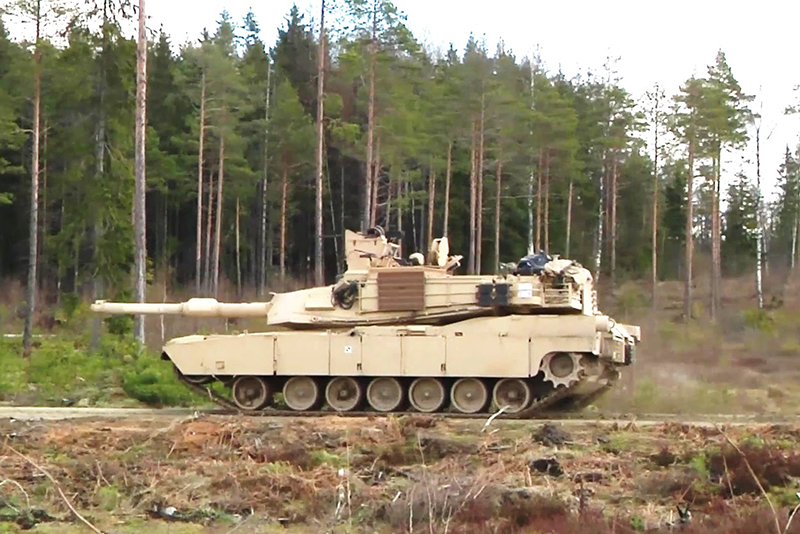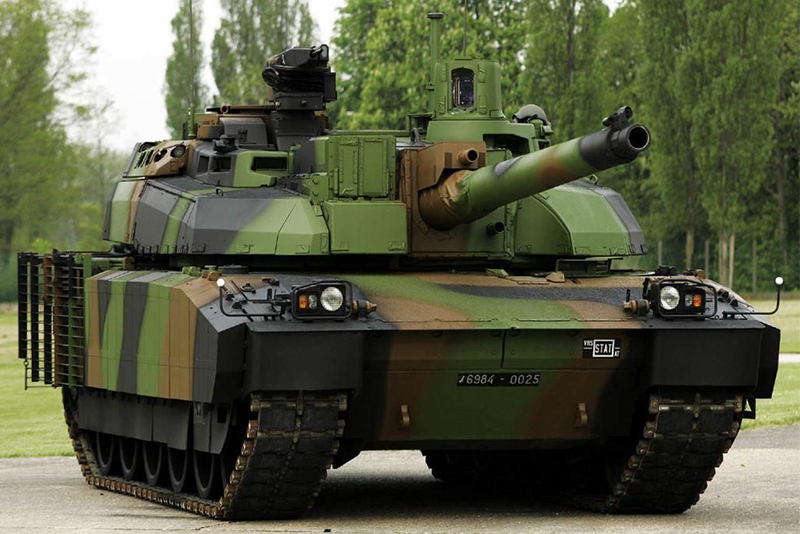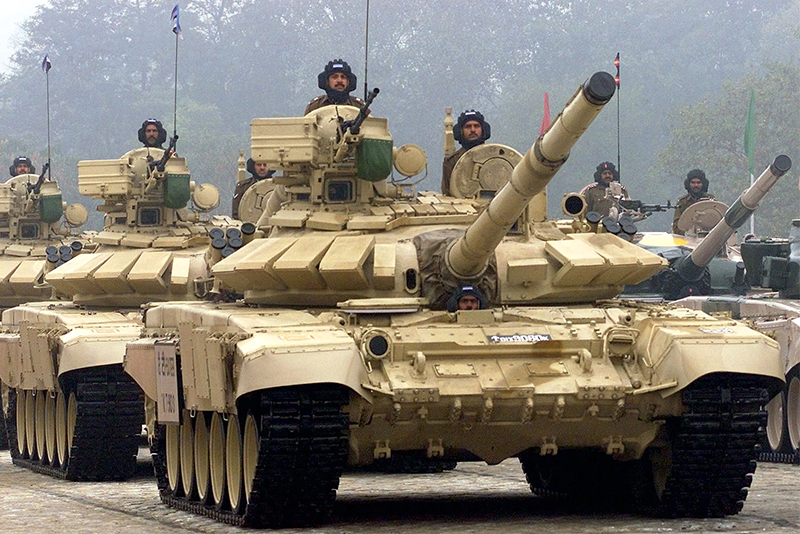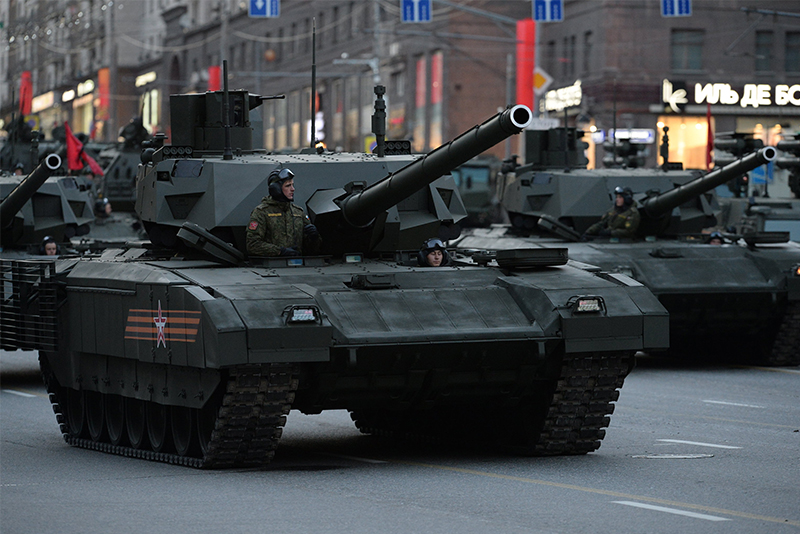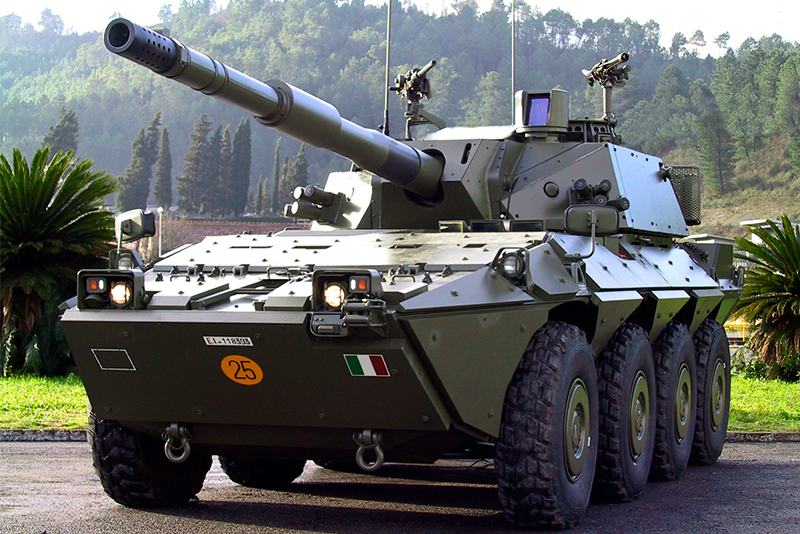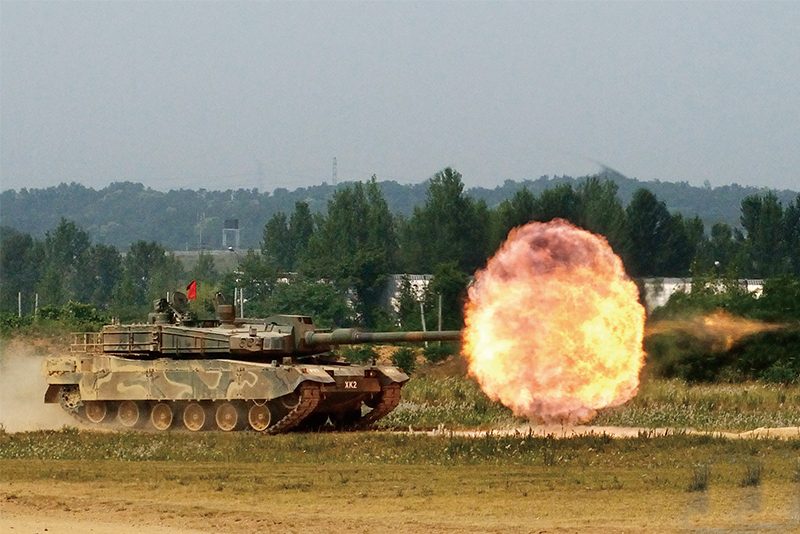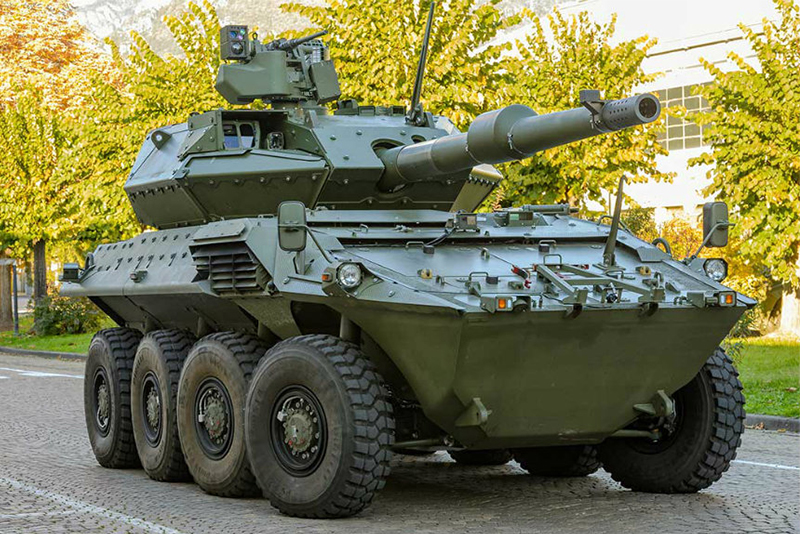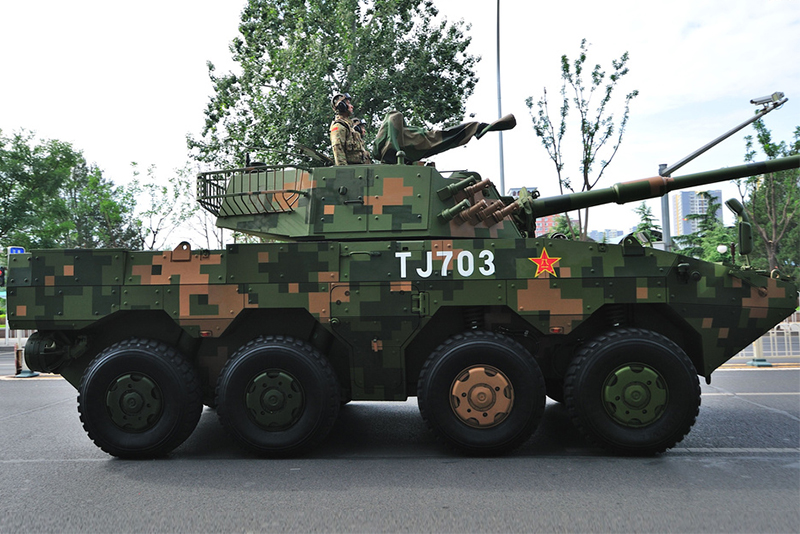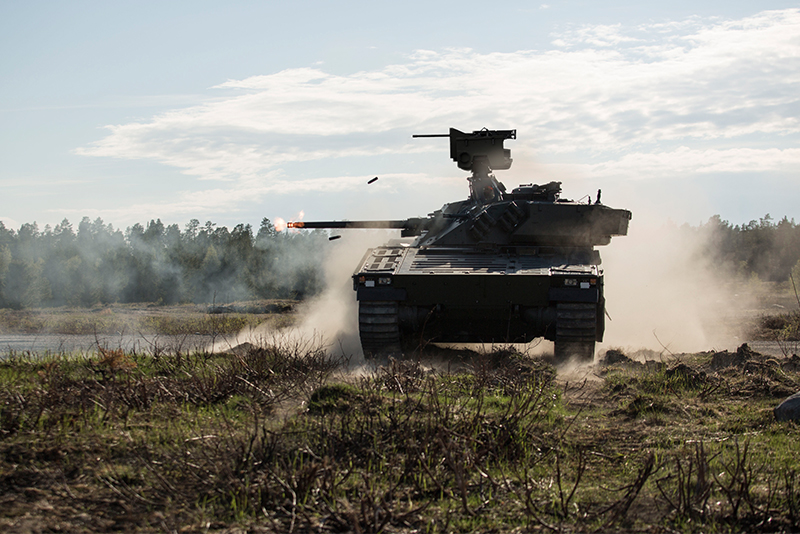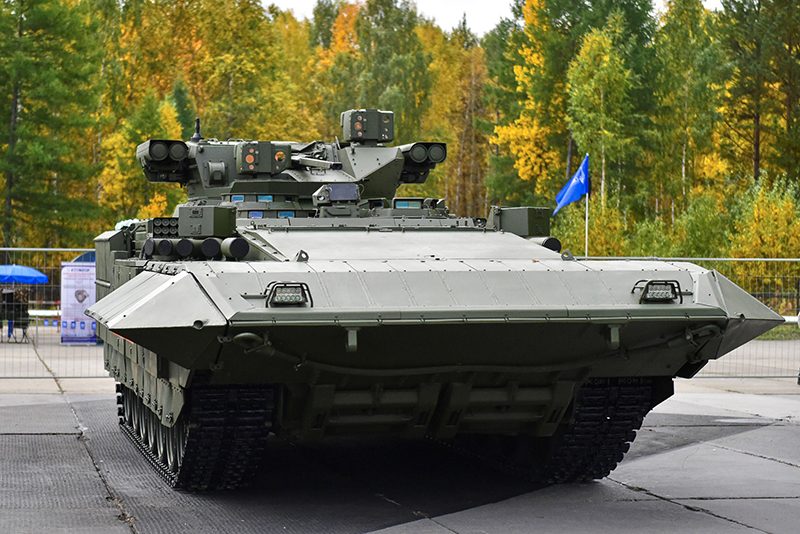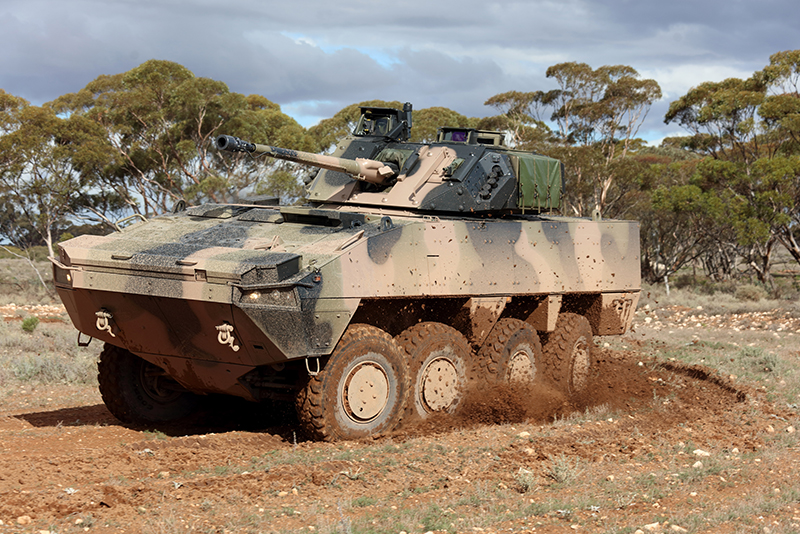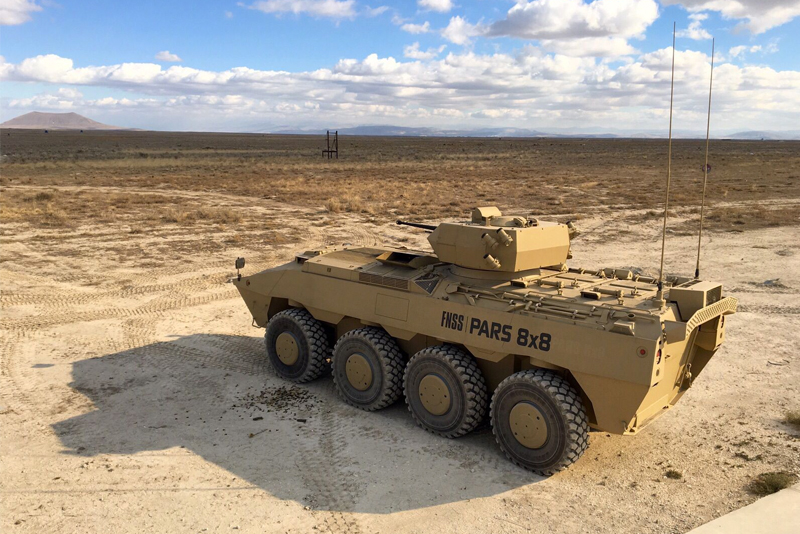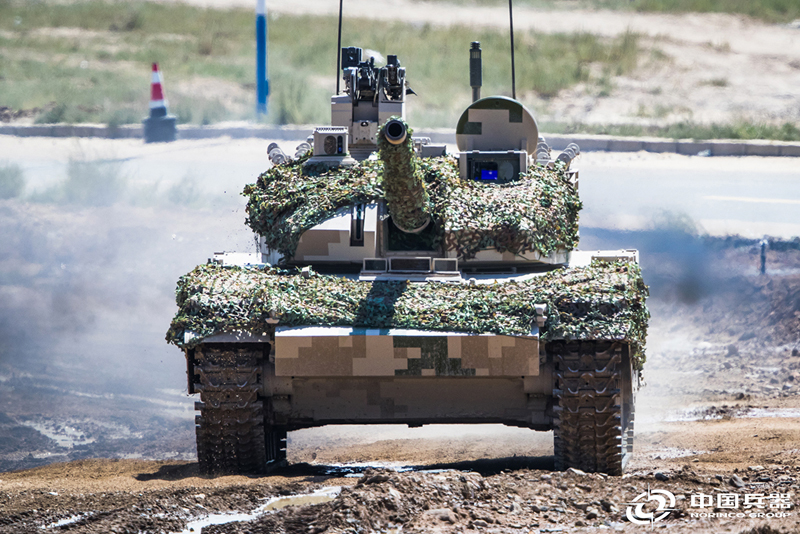Armoured vehicles come in many shapes and sizes, with differing roles. This compendium will examine two categories: armoured fighting vehicles (AFV) used for direct fire and those that also carry infantry into the fight.
The term ‘armoured vehicles’ is a broad one. It can cover vehicles that simply have armour protection for the occupants through to complete combat systems that may be as sophisticated in their own way as a jet fighter or a naval warship. In fact, there are increasing parallels between combat systems used in the land, sea and air domains.
This broad collection of ‘armoured’ vehicles makes any discussion a challenge. Attempting to categorise them is, in itself, difficult. Using the terms ‘light’, ‘medium’ and ‘heavy’ was at one time reasonable. It reflected the weight of a system, which in turn correlated closely with the level of protection, since protection was primarily the product of the amount and thickness of armour. The more armour that was provided the greater the protection, and the higher the vehicle weight. There was also a similar correlation between weight and armament, as a heavier vehicle weight was generally required to mount and fire a larger calibre gun. Thus, lighter vehicles typically had smaller guns while heavy ones had larger, longer-range cannon. However, advances in technology have blurred these differences, and have rendered ‘light’, ‘medium’ and ‘heavy’ classifications largely meaningless.
Even the terminologies used to describe the properties of armoured vehicles require change if they are to accurately reflect specific characteristics and how they are achieved. For example, ‘protection’ may be more appropriately referred to as ‘survivability’. This better describes the complex collection of factors that together contribute to keeping the crew safe and allowing the mission to continue. Similarly, our understanding of ‘mobility’ has changed. Once it was accepted that tracked suspensions were a prerequisite for heavy armament and offered the highest off-road mobility, while limiting speed. Yet today, 70 ton main battle tanks (MBTs) routinely move at 70km/h (44mph) while some wheeled combat systems mount the same armament as MBTs.
Segregating armoured vehicles by mission role has greater value and relevance. Yet, even here differentiation can be complex – partly as a result of technological change. Larger calibre guns can now be applied to lighter weight vehicles, for example. In many cases these new weapons may even be retrofitted to existing vehicles as part of upgrade programmes. Similarly automotive advances including more compact, lighter-weight power packs and high performance hydro-pneumatic suspensions are permitting increases in vehicle payloads without compromising mobility. This permits protection and armament to be increased. Significant advances in sensor technology, data processing, communications (including data transfer) and automation, including remote operations, have also opened up new possibilities for combat vehicle developers.
Upgrade and improvement programs may allow fielded vehicles to gain enhanced mission capabilities with moderate investment, often facilitating greater multi-role flexibility. This has tended to reduce the differences between vehicles that may be undertaking different missions. There is a growing recognition of the maintenance, logistics, economic and life cycle benefits of fielding common platforms where appropriate. New technologies, design approaches and manufacturing and support techniques are combining to achieve this ‘single platform/multi-mission’ flexibility.
This compendium examines those armoured vehicles that are directly used in combat. These are the front line vehicles that make up the Schwerpunkt (German: main focus, focal point, or centre of gravity) of armoured warfare. These systems continue to embody the key triad of characteristics of conventional armoured fighting vehicles (AFVs) – firepower, mobility, and protection. Advances in situational awareness and command and control are increasingly augmenting these traditional AFV features, and are driving many of the latest capability improvement programmes.
This compendium divides combat vehicles according to two categories of primary purpose. The first category comprises AFV systems that have the principle role and design focus of delivering fires, which may be thought of as direct fire vehicle systems. This category includes main battle tanks, ‘tank destroyers’, light tanks, mobile direct fire vehicles, mobile protected firepower (MPF) vehicles, and others. All are mobile platforms optimised to deliver highly accurate direct fires with a dedicated crew and incorporating a level of survivability against encountered threats.
The second category consists of combat vehicles that are able to carry infantry who can dismount and fight. Such vehicles may often share some of the features of the first group of direct fire vehicle systems, but with the ability to accommodate an infantry section.
The level to which the triad of AFV characteristics are applied to these vehicles may vary, some having as sophisticated a fire control system as an MBT but with a smaller calibre gun, others being more lightly armoured.
Including direct fire vehicle systems and infantry vehicles in the same compendium makes perfect sense. Both categories of vehicle will often operate together. They are intended to support and complement each other contributing their different key attributes to ensure battlefield success.
M1A2 Abrams
Developer: General Dynamics Land Systems
Origin: United States
Armament: 120mm smoothbore M256
The original M1 Main Battle Tank (MBT) was first fielded in 1980, with a rifled 105mm L/52 M68 gun. The M1A2 was introduced in 1990. Like the M1A1 it uses the M256 120mm smoothbore cannon developed by Rheinmetall AG of Germany for the Leopard 2, but with an improved fire control system and other improvements. The A2 has undergone a number of improvements applied as System Enhancement Packages (SEPs). The most recent Abrams SEP is the M1A2V3, and the first production V3s were delivered in October 2017. Funding issues have limited the introduction of the latest versions across the Army, and as a result large numbers of earlier M1A2 versions remain in wide service. This means that although there are Abrams versions capable of matching the most advanced potential threat, these versions may not necessarily be in the hands of the units that will face them. At the roll-out Maj. Gen. David Bassett, program executive officer for Ground Combat Systems reflected that “Abrams M1A2 SEPv3 is a great step forward in reliability, sustainability, protection, and on-board power which positions the Abrams tank and our ABCTs for the future. Even in a fiscal environment that has greatly hampered our ability to move towards entirely new vehicles, the Abrams M1A2 SEPv3 shows we can still deliver meaningful and operationally relevant improvements.” The Army has already initiated development of a V4 configuration.
Leopard 2
Developer: Kraus-Maffei-Wegmann (KMW)/Rheinmetall
Origin: Germany
Armament: 120mm smoothbore Rheinmetall L/55
The Leopard 2 is one of the most widely-fielded MBTs. Introduced in the 1980s, it has been continuously upgraded and improved in response to battlefield challenges, through the application of new technologies and innovations. The tank owes its worldwide success to these core improvements but also to the active promotion of modifications and upgrades that customize its capabilities for different end users and geographic regions. Some recent customers have taken advantage of the availability of surplus Leopards from NATO armies. Many Leopard 2 upgrades have been undertaken and offered though Rheinmetall and some have included collaboration with local industries. The German Bundeswehr has entirely equipped with the Leopard 2A7V. It also recently elected to pursue the Combat Capability Improvement IV (Kampfwertsteigerung IV, KWS IV) programme. This will allow the German Army to upgrade part of its MBT fleet to a new Leopard 2A8 standard as an interim to finalizing development of a new MBT (the Main Ground Combat System, or Leopard 3). Leopard 2 variants are in service in 18 countries and half a dozen more nations have shown interest in acquiring new or surplus tanks from various sources.
LeClerc
Developer: Nexter (Previously GIAT)
Origin: France
Armament: 120mm smoothbore CN 120-26
Fielded in 1991, LeClerc anticipated many of the features now common in combat vehicles including onboard battle management. The main gun (at 52 calibre length, rather than the more usual 44) provides higher muzzle velocity and a flatter trajectory. It also has an automatic loader and integrated fire control that can engage six targets in 60 seconds with 95% accuracy. The coaxial machine gun is the larger 12.7 mm. It sported one of the first hydro-pneumatic suspension systems on an MBT. LeClerc is currently undergoing an upgrade that includes a remote weapon station (RWS), additional modular armour on the hull and turret, new radios, and the SCORPION battlefield management and command system. The gun also incorporates an interface to allow use of programmed air-burst ammunition. LeClerc is also used by the UAE and has seen combat in the Yemen conflict.
Challenger 2
Developer: Vickers Defence Systems (now BAE Systems Land & Armaments)
Origin: United Kingdom
Armament: 120mm Rifled L30A1
The FV 4034 Challenger 2 MBT is the successor to the Challenger 1, and entered service in 1994. It is operated by the British Army and the Royal Army of Oman. In addition to a rifled 120mm main cannon its uses a 7.62mm L94A1 chain gun (EX-34) as its coaxial armament, both representing unique armament applications for a NATO MBT. The use of a rifled barrel on the main gun is unique among modern MBTs, it was chosen because the British Army continues to place great emphasis on the use of High-Explosive Squash Head (HESH) rounds in addition to Armour-Piercing Fin-Stabilised Discarding-Sabot (APFDS) rounds. Another unique aspect is that the main cannon uses projectile and propellant charges that are loaded separately into the gun. Protection is provided by second generation Chobham armour (known as Dorchester) with reactive armour and bar armour panel kits fitted as required. The steel underbelly was lined with armour as part of the ‘Streetfighter’ upgrade.
Currently the UK MoD is pursuing a Life Extension Project (LEP). It awarded contacts at the end of 2016 to both a Rheinmetall Landsystems lead team and a BAE Systems team to provide solutions for the assessment phase. This may be followed by demonstration and manufacturing phases. Proposals are understood to include new thermal and commander’s sights, upgraded fire control systems, new displays, open-architecture systems, threat warning and a situational awareness system. Notably neither proposal addresses gun changes or automotive, particular power, upgrades. The MoD has however, contracted with QinetiQ to assess active defence systems for Challenger as part of its MEDUSA Project.
T-90S
Developer: Uralvagonzavod
Origin: Russia
Armament: 125mm smoothbore 2A46M
The T-90 (and specifically the T-90S) is the most widely employed MBT in the Russian Army and is also in widespread use with other armies, including Syria and India. The most recent Indian T-90s are being manufactured under license in Avadi, Tamil Nadu. The T-90 (originally designated T-72BU) was derived from the T-72B and T-80U, but with significant improvements and upgrades. The 125mm cannon is stabilized in two axes and fires both conventional projectiles and cannon launched guided missile and uses an automatic carousel loader. The missile provides long-range engagement (4,000-5,000 meters) using laser beam riding and has a shaped charge (chemical energy) warhead. The fire control system and day/night (thermal) sights offer effective conventional engagements with target identification up to 1,500 metres even in reduced visibility. Protection is provided by a mix of conventional armour and explosive reactive armour, and by the Shtora-1 defensive aids suite. This suite consists of infrared jammer, laser warning sensors, and a grenade launcher system.
T-14 Armata
Developer: Uralvagonzavod
Origin: Russia
Armament: 125mm smoothbore 2A82-1M
The Armata caused quite a stir in the West when it was first shown in 2015. It incorporates a number of innovative design features including a universal chassis, an unmanned turret, an armoured crew capsule, and is equipped with improved main armament, and additional protective measures. The main gun can fire a range of new projectiles and guided missiles. The Vacuum-1 sabot round has a 900mm penetrator that can penetrate 1,000mm of rolled homogeneous armour (RHA) equivalent at 2,000m. The 2A82-1M main gun can also fire a controlled-detonation Telnik High explosive/fragmentation round and is compatible with the 9M119M1 Invar-M missile, which has a range of 5,000m. Crew protection is enhanced by their central placement in the hull and by the Afghanit active protection system (APS). This uses a millimetre-wave radar to detect and track threats. The T-14 incorporates an active electronically scanned array (AESA) radar, multispectral commander’s and gunner’s sights, networked sensors and automatic target detection. Russia claims that its thermal sights can see tank targets at 5,000 m, though it is worth noting that its earlier high performance thermal cameras were of French origin.
Further reports on the progress of the T-14 and its fielding and performance have been mixed and there is speculation that production thus far has been limited. Its design does, however, reflect a number of approaches that have realized in other armoured combat vehicles.
Oplot T-84
Developer: Kharkiv Morozov Machine Building Design Bureau (KMDB)
Origin: Ukraine
Armament: 125mm Smoothbore Model KBA-3
The Oplot is the result of continued effort to improve the T-80 MBT which had been manufactured by KMDB. The first was the T-84U which added armoured side skirts, Kontakt-5 explosive reactive armour to the turret, an auxiliary power unit, thermal imaging sights, commander’s laser range-finder, a muzzle reference system and navigation. This was followed by the T-84 Oplot and more recently the T-84M or BM. Here the tank is equipped with a completely new welded turret (retaining the 125mm gun) with a bustle auto-loader (vice the carousel type), segregated ammunition storage, and upgraded fire controls including hunter-killer capability. More advanced passive and active armour and countermeasures were also included. A major focus has been given to securing export orders for the tank with a number of unsuccessful presentations. An order secured with Thailand incurred delivery delays although it was fulfilled.
Merkava
Developer: MANTAK
Origin: Israel
Armament: 120 mm MG253 (M68) smoothbore
The Merkava (Chariot) was designed to meet Israeli Defence Force requirements, entering service in 1978. The front mounted engine allows a rear hull compartment to be used to carry ammunition, troops or casualties. The latest Merkava IV incorporates a host of new technologies, including a modernised El-Op Knight Mark 4 fire control system with automatic target tracking and improved thermal imaging, and with a capability against flying helicopters. The tank also incorporates a range of thermal signature reduction measures. The Merkava IV also features a locally developed composite armour with modular supplementary armour. In addition to 7.62mm coaxial and roof-mounted machine guns it is often fitted with a 0.50in heavy machine gun mounted on the main gun mantle and also has an internal 60mm light mortar that can deliver smoke grenades. The Merkava Mk 4M is equipped with the Trophy active protection system, a combat-proven Israeli-developed hard-kill defence system linked to laser and radar warning systems and able to engage any incoming missile/projectile and to indicate the estimated location from which it was fired. The Tzayad battlefield management system can relay this information to other vehicles, allowing them to take evasive action or to engage the threat.
K-2 Black Panther
Developer: Agency for Defense Development/Hyundai Rotem
Origin: Republic of Korea
Armament: Rheinmetall 120 mm/L55 smoothbore
The K-2 Black Panther is a Korean-designed and developed MBT. It is optimized for operating in mountainous Korean terrain, and entered service in limited numbers in 2014, with an indigenous engine. The K2 officially entered service in 2016 using a license produced MTU 883 engine and RENK transmission. The intent was to manufacture the second lot of K-2 using a 1500 hp Doosan powerpack and locally developed S&T Dynamics automatic transmission, but the transmission did not meet required reliability standards, delaying further production until 2019. The second batch will now have a ‘hybrid’ powerpack consisting of the locally developed engine with the German RENK transmission system. The K-2 also incorporates a number of unique features including an extended range KSTAM top-attack munition fired from the main gun (a 55 calibre length, higher velocity 120mm main gun based on the Rheinmetall L55), a hydro-pneumatic suspension that allows the tank to ‘squat’ in order to achieve a lower firing profile, a millimetre band radar linked to the fire control system, and a special layered composite and reactive armour. What could not be developed locally was licence produced or reverse engineered. Korea has aspirations for exporting defence systems and secured a collaborative agreement with Otokar to use K-2 technology in the development of Turkey’s Altay MBT.
MMWT (Modern Medium Weight Tank)
Developer: PT Pindad (Indonesia) with FNSS (Turkey)
Origin: Indonesia
Armament: Cockerill 105mm rifled high pressure gun
The MMWT (Modern Medium Weight Tank) is the product of a co-operative development programme between Indonesia and Turkey. Provisionally known as the Kaplan (Turkish) or Harimau Hitam (Black Tiger) the MMWT is intended to provide an MBT best suited to meet Indonesian and Asia-Pacific requirements. The first prototype was built by FNSS in Turkey while a second is being completed by PT Pindad. The tank was shown in Indonesia’s military parade in October 2017. It uses the CMI Cockerill 3105 two-man turret with a high-pressure 105mm rifled cannon and a bustle mounted autoloader. Basic protection is provided against 12.7mm rounds and mine blasts, with add-on armour providing protection against 25mm armoured piercing rounds. The tank has a 20 hp:tonne power-to-weight ratio and incorporates an auxiliary power unit (APU).
Centauro
Developer: Società Consortile Iveco Fiat -Oto Melara (CIO)
Origin: Italy
Armament: Oto Melara 105 mm/52 calibre gyro-stabilized high-pressure, low-recoil gun or Low Recoil 120mm/45 gun
The Centauro name is used by a family of Italian military vehicles based on a 24,000kg wheeled tank destroyer. The Centauro combines the favourable attributes of a wheeled chassis (Iveco Fiat was tasked with developing the hull and propulsion systems), with the firepower and lethality of a major calibre gun and turret (developed by Oto Melara). The wheeled design allows Centauro to undertake expedited road marches and to redeploy by road or air more quickly than an MBT could. The first models were fielded in 1991 and employed a 105mm tank gun capable of using NATO standard ammunitions including APFSDS (Armour-Piercing Fin-Stabilized Discarding Sabot) high velocity anti-armour rounds. The Centauro II is bigger, more powerful and better wired than the original Centauro, which it will replace, and incorporates a 120mm/45 gun, a new fire control system, new sights and an optional HITROLE remote weapon station. The Centauro platform has been used as the basis for a range of specialised derivatives including the Freccia IFV, personnel carrier, mortar carrier, and recovery variants.
Type 16 Manoeuvre Combat Vehicle (MCV)
Developer: Mitsubishi Heavy Industries
Origin: Japan
Armament: Japan Steel Works 105mm rifled cannon
The MCV was designed to meet a Japan Ground Self-Defense Force requirement for a highly mobile direct fire asset that would be deployable by sea or by air on board the new Kawasaki C-2 transport aircraft. It is a key element of the forward defence approach. First fielded in 2016, this 8×8 has modular armour offering 40mm frontal protection, with armour panels that can be replaced when damaged. The 105mm cannon fires standard NATO ammunition.
ZTL-09
Developer: NORINCO
Origin: Peoples Republic of China
Armament: 105mm cannon
The ZTL-09 was introduced in 2009 and is based on a modified version of the older ZTL-08 8×8 chassis, with a forward-mounted engine. The 105mm gun is manually loaded and the turret also has a 7.62mm coaxial machine gun, with digital fire control and gun stabilization. The main gun fires conventional ammunition and a cannon launched laser-guided missile. Frontal protection is provided against rounds of up to 25mm. Powered by a Chinese built 440 hp Deutz BF6M1015C diesel engine the vehicle can ‘swim’ using twin water jets.
WMA301
Developer: NORINCO
Origin: Peoples Republic of China
Armament: 105mm cannon
The WMA301 was developed for export by NORINCO. It is based on the PTL-02 6×6, but uses a 105mm cannon that is compatible with NATO ammunition instead of the PTL-02’s 100mm gun. The main gun can also fire a NORINCO guided missile. Fire control systems are simpler, because the vehicle is targeted at export customers. It has been widely fielded in Africa (Cameroon, Chad, and Djibouti) and by Myanmar.
AMX-10RCR (Renové)
Developer: NEXTER
Origin: France
Armament: GIAT F2 105 mm rifled cannon
The Renové programme upgraded 256 French Army AMX-10RC 6×6 light reconnaissance vehicles between 2005 and 2010. The upgrade included add-on armour, a Sagem active protection system, LIRE infrared jamming system, SIT-IV battlefield management information system, and a new identification friend or foe system, as well as Galix smoke grenades. The vehicle also gained a new automatic transmission and new controls for the height adjusting hydro-pneumatic suspension system. It commander has a panoramic sight but the gun is not stabilized so the vehicle halts briefly to fire. The gun’s velocity is 1400m/s and it has a range of rounds including High Explosives, APFSDS and an improved HEAT round. The AMX-10RC and RCR are capable of rapid deployment and have been regularly employed in French expeditionary operations. The AMX-10RC is also used by Morocco and Qatar.
VBCI / VBCI- 2 Véhicule Blindé de Combat d’Infanterie
Developer: Nexter
Origin: France
Armament:
The VBCI or (Véhicule Blindé de Combat d’Infanterie or Armoured vehicle for infantry combat) is an 8×8 IFV (Infantry Fighting Vehicle) fielded by the French Army in 2009. It has a DRAGAR one man Turret with a 25 mm stabilized gun, thermal sights, and laser rangefinder. With an empty mass of less than 18 tonnes the VBCI was designed to be air transportable on board the Airbus A400M.
In 2015 Nexter displayed an improved version with increased gross weight (allowing improved armour protection), a reconfigured interior, and rear-wheel steering giving a reduced turning radius of 20 metres. The VBCI-2 is a private venture development by Nexter aimed at the export market. It features a new more powerful Volvo D13 turbocharged diesel engine, a new air conditioning system, and new thermal cameras. The VBCI-2 is fitted with a T40 two-man turret armed with the 40 mm CTAS cannon, as well as two tubes of anti-tank guided missiles. The vehicle can be offered with a remotely-controlled turret with a 30 mm cannon or a complete Russian BMP-3 turret.
Namer
Developer: Israel Military Industries/Israeli Ordnance Corps.
Origin: Israel
Armament: .50cal MG, 40mm AGL Remote Weapon Station or 30mm RWS
Namer is probably the most heavily armoured infantry carrier fielded. The chassis and automotive system is based on the Merkava MBT but the Namer (leopard) incorporates a raised troop compartment and enlarged rear door ramp to allow nine infantry to be carried in addition to the three crew. It was first fielded with a Samson RCWS (Remote Controlled Weapon Station) mounting either a .50 machine gun or 40mm automatic grenade launcher. The 60mm mortar (as used on the MBT) is also included. In July 2107 Namer was demonstrated with 30mm auto-cannon in a remote station. It is also having the Trophy APS mounted and is fitted with the IDF (Israel Defence Force) Battlefield Management system. Although it entered service in 2008 the rate of fielding has been modest.
CV-90
Developer: Försvarets materielverk (FMV), BAE Systems Hägglunds, Bofors
Origin: Sweden
Armament: 40mm Bofors Autocannon, 30mm Bushmaster cannon or other cannon up to 120mm
The CV-90 first entered service with the Swedish Army in 1993, having been developed specifically for the Nordic sub-arctic climate, with good mobility in snow and wetlands, The CV-90 was originally designed with a 40mm Bofors L70 auto-cannon and carrying a six-to-eight man infantry section. Operated by eight armies, the CV-90 has been fitted with a range or armament options. In the IFV and reconnaissance roles it has mounted the 30mm Bushmaster II and 35mm/50 cal Bushmaster III, and variants have been produced with 105mm gun/turrets from BAE-Nexter and CMI (the Cockerill XC-8 turret), a 120mm RUAG Compact Tank Gun and even the Mjölner 120mm mortar. One up-gunned CV-90 variant forms the basis of the Polish PL-01 light tank. Each CV90 evolution has increased its payload and protection level while also responding to new threats including mines and IEDs. Ballistic protection is provided against projectiles of up to 30mm and there are provisions for countering handheld anti-armour weapons.
The latest CV-90, the Mark IV, was unveiled in January 2017, powered by a new 1000hp Scania engine with an upgraded X300 heavy-duty transmission and a two tonne increase in payload. The Mark IV incorporates BAE Systems iFighting computer system that integrates the vehicle’s sensors, weapons, and that offers enhanced enhance situational awarenss and tactical decision making support to the crew.
M-2 Bradley IFV
Developer: BAE Systems
Origin: United States
Armament: M242 25mm Bushmaster plus two TOW ATGMs
The Bradley remains the US Army’s ABCT (Armoured Brigade Combat Team) infantry fighting vehicle. It entered service in 1981 and has been progressively improved and upgraded since then. The M2A3 upgrade introduced the Improved Bradley Acquisition System (IBAS) for the TOW missile and a commander’s independent thermal viewer (CITV) using second-generation Horizontal Technology Initiative (HTI) cameras. The M2A2 ODS (Operation Desert Storm) version and the Bradley Urban Survivability Kit (BUSK) enhanced survivability, and added digital command and control, and navigation systems, and also provided improved fire control, and driver night vision. The latest M2A3 variant has digitized electronics, improved targeting and compatability with add-on reactive armour. The M2A3 takes advantages of the many TOW upgrades and lethality improvements. Current upgrade and modernisation efforts seek to restore performance lost as a result of increased weight, and to address a range of space, weight, and power-cooling (SWaP-C) issues. Engineering Change Proposal 1 (ECP 1) upgrades the suspension to restore ground clearance and adds belly armour. ECP 2 increases electrical power generation to accommodate new sensors, networking and electronic warfare systems.
BAE has proposed the M2A4, which (much like the Stryker DVH program), replaces the existing M2 chassis and hull with a vastly modernized one. The hull is redesigned for survivability with a thinker bottom, 175mm higher roof and changes to improve mine resistance. It also has more power and larger electrical capacity to address increased on-board system demands. Funding constraints mean that a significant proportion of the Bradley fleet remains without some of the identified improvements.
Puma
Developer: Projekt System Management GmbH (PSM)
Origin: Germany
Armament: 30 mm Mauser MK 30-2/Air Burst Munition (ABM) autocannon
Produced by the PSM Joint Venture formed by Krauss-Maffei Wegmann and Rheinmetall Landsysteme, the Puma (Schutzenpanzer Puma) began replacing the Marder fighting vehicle in 2015. Its configuration takes advantage of improvements in optics/video and data networking technology utilizing a remotely operated turret and armament. The entire crew is located in the chassis hull as are the embarked infantry section. The roof panoramic multi-sensor sight, primary gun sight, driver’s viewer and perimeter video sensors can be viewed from any position in the vehicle. Base protection is provided by AMAP-B composite armour with provisions to increase this through additional armour modules. This also allows for easy replacement of damaged armour. Non-explosive reactive armour (NERA) also appears to be utilized on Puma. The MUSS (Multi-functional Self Protection System) a soft-kill active protection system is also to be fitted. Puma is powered by an 1100hp MTU V10 892 diesel engine. Though it was first fielded in 2009, the Puma is already being upgraded. Rheinmetall received a Bundeswehr contact in July 2017 that included providing colour displays and a turret-independent secondary weapon system that would be controlled from the rear fighting compartment against threats out to 400 meters.
BMP-3
Developer: Kurganmashzavod
Origin: Russia
Armament: 2A48-1 100mm rifled cannon plus 2A72 30mm auto-cannon and two 9K116-3 ‘Basnya’ ATGMs
The BMP-3 (Boevaya Mashina Pehoty-3 or Infantry Combat Vehicle-3) IFV officially entered service with the Soviet Army in 1987. The BMP-3 is fitted with a two-man turret mounting a 100mm cannon capable of firing auto-loaded laser-guided 9M117 (AT-10 ‘Stabber’) anti-tank guided missiles and conventional high explosive fragmentation (HE-FRAG) rounds. It also carries a dual-feed 30mm cannon with HE and AP ammunition. The driver sits in the centre bow flanked by two of the seven infantry dismounts with another five behind the turret. Because the fuel cell is in the bow and the engine is in the rear infantry have to dismount via overhead hatches and over the power pack. The BMP-3 features a hydro-pneumatic suspension and is fitted with water jets for swimming. Frontal protection is provided against 30mm strikes, with all-aspect protection against 14.5mm rounds. A number of upgraded BMP-3M variants have been produced with a new turret and alternative engines, additional armour, improved fire controls and thermal sights, and ‘Arena-E’ or ‘Shtora-1’ active protection systems.
The BMP-3M Dragun variant is powered by a forward-mounted 816 hp engine and has a reconfigured interior carrying eight infantry who can exit using a rear ramp. The Dragun also uses a remote controlled version of the 100mm/30mm turret.
Freccia IFV
Developer: IVECO/Oto Melara (Leonardo) CIO
Origin: Italy
Armament: Oerlikon KBA 25mm automatic cannon
Freccia was one of the first wheeled 8×8 infantry fighting vehicles. It uses the automotive baseline of the Centauro but mounts the Hitfist Plus two amn turret with an auto cannon and coaxial machinegun in the IFV model. The Freccia is a family of vehicles which includes anti-tank missile, command, command post, mortar, ambulance, recovery, and ISTAR reconnaissance variants. Its 22.2 hp/tonne power to weight ratio and hydro-pneumatic suspension provide on and off-road mobility.
K-21 IFV (Korea)
Developer: Hanwha Defence Systems/Agency for Defense Development
Origin: Republic of Korea
Armament: 40mm Bofors XK autocannon plus two ATGMs
Intended to met the specific circumstances of combat on the Korean Peninsula the K-21presents a unique collection of capabilities. It is well protected against 30mm frontal impacts and well armed with a Bofors XK 40mm cannon. The fire control system is equivalent to those fitted to MBTs. Its autocannon can fire a range of armoured piecing sabot, HE-FRAG, air-burst, smoke and multi-purpose ammunition allowing the K-21 to engage, suppress and defeat ground and even helicopter targets. The K-21 also carries two indigenously developed fire and forget anti-tank guided missiles that allow the vehicle to halt briefly, lock-on, launch and then move again. With a power to weight ratio of around 27hp/tonne it is well suited to the hilly terrain in which it must operate. Further it has integrated side floatation pontoons that can be inflated for crossing the country’s many rivers. The K-21 carries three crew and eight infantry comfortably with nine possible.
T-15 Armata IFV
Developer: Uralvagonzavod
Origin: Russia
Armament: 2A42 30 millimetre automatic cannon plus four AT-14 Kornet-EM anti-tank missiles
The T-15 is the Infantry Fighting Vehicle complement to the T-14 Armata MBT, with both vehicles forming part of a universal combat platform concept which will eventually include a range of armoured systems. The IFV uses the same chassis but is configured to carry infantry while using a remote-controlled Epoch turret with a 2A42 30 millimetre automatic cannon, a PKT machinegun and four AT-14 Kornet-EM fire-and-forget anti-tank missiles. This turret is also used on the Boomerang wheeled armoured infantry carrier and the Kurganets tracked infantry fighting vehicles. The T-15 is expected to have the same armour and defensive aids as the T-14 but the number of dismounts remains unclear. Thus far production seems to be limited to prototypes and test vehicles.
Kurganets-25 IFV
Developer: Kurganmashzavod
Origin: Russia
Armament: 2A42 30 millimetre automatic cannon plus four AT-14 Kornet-EM anti-tank missiles
At 25 tons the Kurganets is clearly more lightly armoured than the T-15, though the IFV version does use the same basic remote-controlled Epoch turret. It carries an infantry dismount section of six or seven (references differ on this) and a crew of three, all located in the hull. It reportedly has a top speed of 80kmh and can swim – as evidenced by a folding bow trim vane and twin aft water jets. There is a version without the turret, but with a remote machine gun weapon station. This may be a personnel carrier variant, or may provide the chassis for support roles. It is speculated that it will play the same role as the current BMP.
T-17 Bumerang IFV
Developer: Kurganmashzavod
Origin: Russia
Armament: 2A42 30 millimetre automatic cannon plus four AT-14 Kornet-EM anti-tank missiles
Bumerang is a wheeled 8×8 IFV using the same remote-controlled Epoch turret as the T-15 Armata. It has a crew of three and can accommodate seven to nine infantry (reports vary). It is understood to have basic small arms armour but can accept ceramic add-on armour for 14.5mm protection. It uses a V-shaped hull to better resist mine blasts. Its estimated speed is around 100 kmph and it can swim using water jets. Other versions are anticipated without the turret to fill other support roles. Though the Army had initial vehicles as early as 2013 testing was still ongoing in 2017. A July 2017 ‘Russia Beyond’ article suggests that the T-17 may enter production in 2019.
Boxer
Developer: ARTEC GmbH
Origin: Germany/UK/Netherlands
Armament: Up to 35mm (demonstrated)
The Boxer is the product of a co-operative European programme to develop the next generation of armoured utility vehicle. France withdrew from the project in 1999 to concentrate on its own VBCI, and the UK withdrew in 2003 in favour of its own the Future Rapid Effect System (FRES). Larger than its contemporaries, the Boxer was the first of a new generation of 30+ tonne IFVs. Boxer consists of two key elements, with a platform/drive-line and a removable, replaceable mission module. The platform incorporates a 720 hp MTU 8V199 TE20 diesel engine, Allison HD4070 fully automatic transmission and front two axial steering endowing the vehicle with excellent performance and mobility.
Mission modules are attached by four points and can be swapped within an hour under field conditions, and allow the vehicle to be rapidly adapted to meet different operational requirements. Modules include APC, IFV, command post, engineer, battle damage repair (Netherlands), cargo and ambulance versions. A wide range of remote weapons stations can be fitted, with a variety of machine guns and autocannon and with a choice of fire control and sighting systems. Lithuanian Boxers feature the Israeli RAFAEL Samson Mk II weapon station with a 30 mm gun and Spike-LR anti-tank missiles. Australian Boxer CRVs will mount the Rheinmetall LANCE 30 mm two-man turret, fitted with the Rheinmetall Mauser MK30-2/ABM dual-feed stabilised cannon and 7.62 mm coaxial MG. Krauss-Maffei Wegmann (KMW) has also integrated its 155 mm/52-calibre Artillery Gun Module (AGM) suggests that the Boxer’s multi-mission applications may have only just begun to be realized.
AMV
Developer: Patria
Origin: Finland
Armament: Up to 105mm
The AMV is a fourth generation modular armoured vehicle offered in three main variants: a basic platform for APC, IFV, C2, ambulance, reconnaissance, mortar carrier, FCV, ATGM and MGS applications, a high roof platform and a heavy weapon platform with a stronger structure, enabling the fitting of heavy weapon systems, including turreted 120mm mortars like Patria’s Nemo and 105/120 mm cannon. The Polish Wilk derivative is fitted with a CMI CT-CV 105HP turret. A range of different turrets, weapons, sensors, and communications systems can be fitted to all variants. The AMV has protection levels of up to 30-mm in the frontal arc and has exceptional mobility (a measure of speed, agility, and crew comfort) in rough terrain, not least because the suspension is able to adjust each wheel individually. The AMV is used by eight armies worldwide and is license built in Poland and South Africa. Emirati AMVs have seen combat in Yemen. It has been offered to meet British and Bulgarian requirements. In 2013 the AMVXP (Extra Payload Extra Performance, Extra Protection) was introduced as a major improvement, and was delivered to Slovakia.
PIRANHA/ Light Armoured Vehicle/Stryker
Developer: MOWAG, now General Dynamics European Land Systems – Mowag GmbH
Origin: Switzerland/Canada/United States
Armament: Up to 105mm cannon
Dating back to the 1970s, the Piranha family of wheeled armoured vehicles includes 4×4, 6×6, 8×8, and 10×10 wheel versions, and is in service in various versions with 28 armies. Operators include the US Army whose Stryker is based on the Piranha IV-based Canadian LAV III. Though originally built in Switzerland, Piranha derivatives have been built under licence by General Dynamics (Canada), Cardoen and FAMAE (Chile), BAE Systems Land Systems (UK), and in the USA. The adaptability and versatility of the Piranha is illustrated by the fact that Belgium replaced all of its M113s, AIFVs and Leopard 1s with 268 Piranha IIICs in seven variants, converting to an all-wheeled armoured force. The Piranha has been extensively improved and upgraded in service. General Dynamics ECP (Engineering Change Proposal) program for the Stryker has introduced the DVH (Double V Hull) to counter IEDs, and has integrated the Kongsberg 30mm remote turret with further improvements to enhance survivability, restore mobility, enhance reliability, and to introduce new technologies such as open-architecture networking and a digital backbone. The latest Piranha V variant has greater protection and payload than earlier versions but also has better mobility and off-road capability, thanks to higher installed power, a new hydro-pneumatic suspension, central tyre inflation, and higher agility including a 15m turning radius. In field evaluations its performance has reportedly approached that of tracked vehicles.
ARMA
Developer: Otokar
Origin: Turkey
Armament: .50 RWS/ 30mm MIZRAK Unmanned and up to 105mm Cannon
ARMA is being fielded by Turkish industry that reflects the primary trends in wheeled combat vehicles. The ARMA is fielded by the Turkish Army in a 6 X 6 model with the 8 X 8 model introduced by the company in 2011. It has high mobility of a fully independent hydro-pneumatic suspension that is offered, central tire inflation, and a 18.75 hp/ton power to weight ratio. The drive wheels can be selected from 8 X 4 for hard surface to 8 X 8 for cross-country. The armoured monocoque V-shaped steel hull offers mine and IED as well as ballistic protection for the crew and up to 12 dismounts. The chassis is intended to fill a range of missions and it will accept various armament options including the MIZRAK-S 30 unmanned turret with advanced optics, fire control, stabilization and a hunter-killer option. ARMA can be configured as a family of systems which include a direct fire 105mm cannon version. ARMA also incorporates Built-in Test (BIT) into its systems facilitating maintenance trouble shooting.
PARS
Developer: FNSS
Origin: Turkey
Armament: .50cal RWS/ 25mm Turret
FNSS PARS was presented and accepted by the Malaysian Army and fielded there as the AV-8 built in-country by DefTech where it is provided in 12 variants. It uses an advanced computer controlled adjustable hydro-pneumatic suspension that offers exceptional manoeuvrability in both the 6×6 and 8×8 models. It has the driver and commander forward with a unique 180 degree panoramic observation with the power pak behind them. It includes forward and rear CCD and thermal cameras as well. All wheel steering allows a tight eight metre turning radius. The latest PARS III was shown in May 2017. Crew protection is emphasised with blast protected hull, shock mitigating seating, and options for additional ballistic protection up to STANAG IV. The chassis will accept a range of weapons including the Sabre 25mm M242 station, .50cal weapons, and mortars up to 120mm. Oman and the Turkish armies are also known to have fielded PARS.
ZTQ/VT-5 Xinqingtan
Developer: NORINCO
Origin: Peoples Republic of China
Armament: 105mm cannon
The VT-5 the export version of the ZTQ was publically unveiled in 2017 although it was seen earlier in testing. It is understood to weight between 25 and 35 tonnes depending on the armour suite fitted. It is reported to use a hydro-pneumatic suspension and may be outfitted to operate in mountains with thinner air of high altitudes. The cannon fires conventional and gun launched guided missiles. Models shown had panoramic sights and advanced fire controls. It appears to have a remotely operated 12.7mm machine gun and 30mm automatic grenade launcher that would be particularly suited for engaging targets at high angles, further supporting the use in mountainous terrain. Sources speculate that the PLA may be acquiring 300 of the tank while export orders are also sought.




